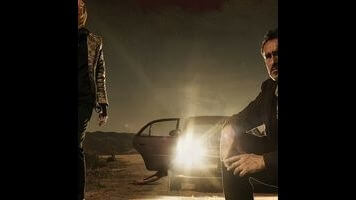The Bridge’s source material hits Hulu

The original version of The Bridge—a co-production by television studios based in Sweden (where it’s known as Bron), Denmark (where it’s Broen), and Germany—is a leading light in the Danish television renaissance, along with political drama Borgen and the crime procedural Forbrydelsen. Like that latter series (which came Stateside as The Killing), The Bridge has been Americanized, with an FX iteration starring Diane Kruger and Demian Bichir. The Brits and the French have their own version as well in the form of The Tunnel. Why does the show’s appeal cross nations and cultures? Because it combines so much of what viewers love about the crime procedural—eccentric investigators, dark humor, red herrings—with a totally bananas plot that never lets up.
The Bridge begins with the discovery of the body of a Swedish politician on the Øresund Bridge, which connects Malmö, Sweden, and Copenhagen, Denmark. The two inspectors that show up to the scene are the Swedish Saga Norén (Sofia Helin) and the Danish Martin Rohde (Kim Bodnia). Forced to work together due to the international nature of their investigation, Saga and Martin soon discover that the original crime is the first in a wide-ranging spree perpetrated by a psychopath who claims to be committing heinous acts to expose the political problems plaguing the Scandinavian nations. For starters, the politician’s body isn’t the only one on the bridge. It’s just her top half, bisected at the waist and fitted with the thawed-out lower half of a Danish prostitute. As the show progresses, the events get bigger in scope, taking on issues of homelessness, mental health, child labor, and integration of immigrants. Yet, there’s no method to the madness, no real message that the anonymous terrorist is trying to get across. The plot barrels along, with conveniently outrageous plot twists that aren’t so bothersome considering how entertaining the show is.
The relationship between the two investigators is what makes The Bridge more than a whacked-out mystery, just as it does in the American version. Bodnia is not as heartbreakingly good as Bichir in the role of the warm cop with little control over his emotions and desires, but that’s because this Bridge is really Saga’s show. Saga is a Holmesian cop, an incredible detective who’s unable to relate on any sort of interpersonal level. While Kruger played her Sonya Cross as cold, distant, and clinical, Helin’s Saga is much more confused by the world. Her portrayal feels innocent and childlike, making her immediately likable in a way that most of the antihero geniuses are not. To her, the world has order and when it does not follow that order, she greets the chaos with the upturned head and wide eyes of a puppy confronting a new experience. Saga is quite aware of her personality. In the middle of the series, she reveals that her sister committed suicide. Martin asks if there were any signs of depression. “I don’t pick up on signs,” she responds. She uses Martin as a means of personal evolution, not because he tells her to—like her boss Hans (Dag Malmberg), Martin has the patience to put up with Saga when nobody else will. (With good reason. In one scene where Saga tries to make small talk with her coworkers, her contribution is that she recently got her period.)








![HBO teases new Euphoria, Larry David, and much more in 2026 sizzle reel [Updated]](https://img.pastemagazine.com/wp-content/avuploads/2025/12/12100344/MixCollage-12-Dec-2025-09-56-AM-9137.jpg)































